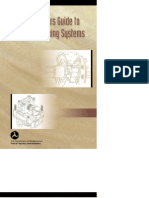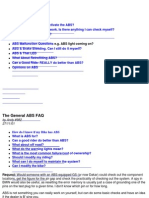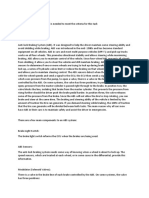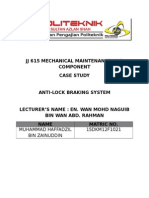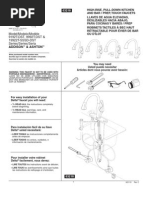0 ratings0% found this document useful (0 votes)
278 viewsYamaha Nmax 155 - Rear Brake Lever
Yamaha Nmax 155 - Rear Brake Lever
Uploaded by
motley crewzThe document summarizes the functions of the rear brake lever and anti-lock brake system (ABS) on a Yamaha motorcycle. It describes that the rear brake lever is located on the left handlebar and engages the rear brake when pulled toward the grip. It also outlines that the ABS uses electronic control systems to independently act on the front and rear brakes, allowing the rider to brake normally while letting the ABS manage brake pulsations. The ABS performs a self-test each time the bike is started and reaches 10 km/h, and has a test mode for owners to experience ABS braking, though special tools are required.
Copyright:
© All Rights Reserved
Available Formats
Download as PDF, TXT or read online from Scribd
Yamaha Nmax 155 - Rear Brake Lever
Yamaha Nmax 155 - Rear Brake Lever
Uploaded by
motley crewz0 ratings0% found this document useful (0 votes)
278 views1 pageThe document summarizes the functions of the rear brake lever and anti-lock brake system (ABS) on a Yamaha motorcycle. It describes that the rear brake lever is located on the left handlebar and engages the rear brake when pulled toward the grip. It also outlines that the ABS uses electronic control systems to independently act on the front and rear brakes, allowing the rider to brake normally while letting the ABS manage brake pulsations. The ABS performs a self-test each time the bike is started and reaches 10 km/h, and has a test mode for owners to experience ABS braking, though special tools are required.
Original Title
Yamaha Nmax 155 - Rear brake lever
Copyright
© © All Rights Reserved
Available Formats
PDF, TXT or read online from Scribd
Share this document
Did you find this document useful?
Is this content inappropriate?
The document summarizes the functions of the rear brake lever and anti-lock brake system (ABS) on a Yamaha motorcycle. It describes that the rear brake lever is located on the left handlebar and engages the rear brake when pulled toward the grip. It also outlines that the ABS uses electronic control systems to independently act on the front and rear brakes, allowing the rider to brake normally while letting the ABS manage brake pulsations. The ABS performs a self-test each time the bike is started and reaches 10 km/h, and has a test mode for owners to experience ABS braking, though special tools are required.
Copyright:
© All Rights Reserved
Available Formats
Download as PDF, TXT or read online from Scribd
Download as pdf or txt
0 ratings0% found this document useful (0 votes)
278 views1 pageYamaha Nmax 155 - Rear Brake Lever
Yamaha Nmax 155 - Rear Brake Lever
Uploaded by
motley crewzThe document summarizes the functions of the rear brake lever and anti-lock brake system (ABS) on a Yamaha motorcycle. It describes that the rear brake lever is located on the left handlebar and engages the rear brake when pulled toward the grip. It also outlines that the ABS uses electronic control systems to independently act on the front and rear brakes, allowing the rider to brake normally while letting the ABS manage brake pulsations. The ABS performs a self-test each time the bike is started and reaches 10 km/h, and has a test mode for owners to experience ABS braking, though special tools are required.
Copyright:
© All Rights Reserved
Available Formats
Download as PDF, TXT or read online from Scribd
Download as pdf or txt
You are on page 1of 1
UB1TE0E0.
book Page 10 Monday, September 9, 2019 4:44 PM
Instrument and control functions
EAU12952 EAU53142
Rear brake lever ABS TIP
The Yamaha ABS (Anti-lock Brake The ABS performs a self-diagno-
System) features a dual electronic con- sis test each time the vehicle first
trol system, which acts on the front and starts off after the key is turned to
1 “ON” and the vehicle has traveled
rear brakes independently.
Operate the brakes with ABS as you at a speed of 10 km/h (6 mi/h) or
would conventional brakes. If the ABS higher. During this test, a “click-
is activated, a pulsating sensation may ing” noise can be heard from the
be felt at the brake levers. In this situa- front of the vehicle, and if either
tion, continue to apply the brakes and brake lever is even slightly ap-
let the ABS work; do not “pump” the plied, a vibration can be felt at the
1. Rear brake lever 6
brakes as this will reduce braking ef- lever, but these do not indicate a
The rear brake lever is located on the fectiveness. malfunction.
left side of the handlebar. To apply the EWA16051 This ABS has a test mode which
rear brake, pull this lever toward the WARNING allows the owner to experience
handlebar grip. Always keep a sufficient distance the pulsation at the brake levers
from the vehicle ahead to match the when the ABS is operating. How-
riding speed even with ABS. ever, special tools are required, so
The ABS performs best with please consult your Yamaha deal-
long braking distances. er.
On certain surfaces, such as ECA20100
rough or gravel roads, the brak- NOTICE
ing distance may be longer with Be careful not to damage the wheel
the ABS than without. sensor or wheel sensor rotor; other-
The ABS is monitored by an ECU, wise, improper performance of the
which will revert the system to conven- ABS will result.
tional braking if a malfunction occurs.
6-10
You might also like
- Pertamina PertashopDocument4 pagesPertamina Pertashopikeuchi_ogawa79% (19)
- Man Tga Flashcodes For EcasDocument6 pagesMan Tga Flashcodes For Ecasrichard100% (73)
- Yamaha Nmax 155 - Stop and Start SystemDocument1 pageYamaha Nmax 155 - Stop and Start Systemmotley crewz0% (1)
- Antilock Brakes, Vehicle Stability ControlDocument24 pagesAntilock Brakes, Vehicle Stability Controlpankh06mechNo ratings yet
- Ford CFT30 CVTDocument5 pagesFord CFT30 CVTAyhan Ümit100% (2)
- 440-T4 / 4T60E / 4T65E 440-T4 / 4T60E / 4T65E: FWD 4 Speed FWD 4 SpeedDocument1 page440-T4 / 4T60E / 4T65E 440-T4 / 4T60E / 4T65E: FWD 4 Speed FWD 4 SpeedCheryl BishopNo ratings yet
- Vehicle Safety Features Fact Sheet Eng ABS 1 PDFDocument4 pagesVehicle Safety Features Fact Sheet Eng ABS 1 PDFkishan1234No ratings yet
- Antilock Braking System (Abs)Document7 pagesAntilock Braking System (Abs)Rushikesh WakodeNo ratings yet
- Hino 700 ABSDocument20 pagesHino 700 ABSjoki marzuki67% (3)
- Ssangyong Rodius ABSDocument9 pagesSsangyong Rodius ABSMTK2016No ratings yet
- Introduction of ABS SystemDocument31 pagesIntroduction of ABS Systemosama tariqNo ratings yet
- Case Study (ABS)Document7 pagesCase Study (ABS)ShivamNo ratings yet
- A Drivers Guide To ABSDocument16 pagesA Drivers Guide To ABSPatrick DuffNo ratings yet
- Anti Lock Braking System Chapter No. 1Document493 pagesAnti Lock Braking System Chapter No. 1pbd123autoNo ratings yet
- Braking System, Anti-Lock Brakes (ABS)Document8 pagesBraking System, Anti-Lock Brakes (ABS)Thanh BuiNo ratings yet
- Antilock Braking SystemDocument8 pagesAntilock Braking SystemAltaf KhanNo ratings yet
- Specification: Unit Description Specification ABS ESP HecuDocument22 pagesSpecification: Unit Description Specification ABS ESP HecuKada Ben youcefNo ratings yet
- Anti-Lock Breaking System 1Document18 pagesAnti-Lock Breaking System 1SOMYA RANJAN TRIPATHYNo ratings yet
- Anti-Lock Brakes: Section 9Document23 pagesAnti-Lock Brakes: Section 9rabitosan100% (1)
- Corollaaxio 201004 Part1 Part7Document12 pagesCorollaaxio 201004 Part1 Part7Saintm101No ratings yet
- Anti-Lock Braking SystemDocument8 pagesAnti-Lock Braking SystemKareem AbdulnasserNo ratings yet
- Sensotronic ServiceDocument6 pagesSensotronic ServiceSi Thu Lwin100% (1)
- Asped: Unit - 5Document5 pagesAsped: Unit - 5Shreeja SPNo ratings yet
- Understanding ABS.Document2 pagesUnderstanding ABS.kolovrataliNo ratings yet
- BMW Abs Brake FaqDocument79 pagesBMW Abs Brake Faqsid8ismNo ratings yet
- Antilock Braking SystemDocument8 pagesAntilock Braking SystemShivam Shakti DubeyNo ratings yet
- Self Study Book 374 Traction Control and Assist Systems - Part 2Document28 pagesSelf Study Book 374 Traction Control and Assist Systems - Part 2flyingspann3rNo ratings yet
- 2015 Volkswagen Passat 25Document12 pages2015 Volkswagen Passat 25talic.hNo ratings yet
- Description: 2009 Dodge Journey R/T 2009 Dodge Journey R/TDocument57 pagesDescription: 2009 Dodge Journey R/T 2009 Dodge Journey R/TMiguel MartinezNo ratings yet
- ABS Operator's Manual: Bendix Antilock Brake Systems Antilock Brake SystemsDocument7 pagesABS Operator's Manual: Bendix Antilock Brake Systems Antilock Brake Systemsfelix3189No ratings yet
- Apache RTR 160 4VDocument95 pagesApache RTR 160 4VUbed Ul HaqueNo ratings yet
- Wheel Speed Sensors: #SecurityinsideDocument8 pagesWheel Speed Sensors: #Securityinsidelizar69No ratings yet
- Apache RTR 200 4VDocument92 pagesApache RTR 200 4VJonathanNo ratings yet
- BHBHBDocument1 pageBHBHBNuh ZakariaNo ratings yet
- Prepared byDocument44 pagesPrepared byOlivier GouveiaNo ratings yet
- A Review of Antilock Braking and Traction Control SystemsDocument8 pagesA Review of Antilock Braking and Traction Control SystemsRamParvathaneniNo ratings yet
- Honda Combined ABS: Press InformationDocument7 pagesHonda Combined ABS: Press Informationapi-3815109No ratings yet
- Marcel Bochna Darragh KeoghDocument1 pageMarcel Bochna Darragh Keoghkonglingxing1122No ratings yet
- Antilock Braking System - Abs: Suzuki Gixxer ABS Suzuki Gixxer SF Fi TVS Apache RTR 180 Abs Suzuki Intruder 150 ABS/FiDocument1 pageAntilock Braking System - Abs: Suzuki Gixxer ABS Suzuki Gixxer SF Fi TVS Apache RTR 180 Abs Suzuki Intruder 150 ABS/FiRabi KantNo ratings yet
- Getting The ABS ConceptDocument4 pagesGetting The ABS ConceptAditya PangestuNo ratings yet
- Getting The ABS ConceptDocument3 pagesGetting The ABS ConceptAditya PangestuNo ratings yet
- Automotive Technology: Presented By, Abhishek KhamkarDocument13 pagesAutomotive Technology: Presented By, Abhishek KhamkarJouaine Sobiono OmbayNo ratings yet
- Specification: Unit Description Specification ABS ESP HecuDocument21 pagesSpecification: Unit Description Specification ABS ESP HecuEfrén SantínNo ratings yet
- Report On Anti Lock Braking SystemDocument12 pagesReport On Anti Lock Braking SystemParth RathoreNo ratings yet
- Y285 WML 717Document17 pagesY285 WML 717Phạm Nguyễn Khánh HuyNo ratings yet
- Jeep Cherokee KL 2015-2019 Brakes 3Document26 pagesJeep Cherokee KL 2015-2019 Brakes 3Henry SilvaNo ratings yet
- 9-3 Brochure en 2007Document33 pages9-3 Brochure en 2007Brian Blair100% (1)
- ABS FunctionDocument4 pagesABS FunctionFilmon TesfayNo ratings yet
- 刹车ABS、EBD原理说明C206 WML 611Document21 pages刹车ABS、EBD原理说明C206 WML 611钱香香No ratings yet
- Fuzzy LogicDocument18 pagesFuzzy LogicLovely AkhilaNo ratings yet
- LV08K Support InformationDocument3 pagesLV08K Support Informationpawel ras50% (2)
- មេរៀន ប្រព័ន្ធហ្វ្រាំង ABSDocument26 pagesមេរៀន ប្រព័ន្ធហ្វ្រាំង ABSYon ChhannakNo ratings yet
- Techmate Technical Guide ABS SensorsDocument2 pagesTechmate Technical Guide ABS SensorspepitoNo ratings yet
- Description: 2009 Chrysler Town & Country LX 2009 Chrysler Town & Country LXDocument41 pagesDescription: 2009 Chrysler Town & Country LX 2009 Chrysler Town & Country LXLarry Lawrence100% (1)
- Presentation On ABSDocument18 pagesPresentation On ABSDipak Kumar100% (1)
- Continental EBS Motorcycle ENDocument4 pagesContinental EBS Motorcycle ENravi kumarNo ratings yet
- Service TipsDocument1 pageService TipsLuis Alberto GarciaNo ratings yet
- MTZABSADocument16 pagesMTZABSArahul patilNo ratings yet
- Antilock Braking System (ABS) in Automobiles PDFDocument5 pagesAntilock Braking System (ABS) in Automobiles PDFInternational Journal of Innovative Science and Research TechnologyNo ratings yet
- ReviewDocument8 pagesReviewsayoseidNo ratings yet
- JJ 615 Mechanical Maintenance and Component (Case Study Abs)Document17 pagesJJ 615 Mechanical Maintenance and Component (Case Study Abs)Muhammad AiminNo ratings yet
- Model FB Anti Lock Brake System 77-1Document63 pagesModel FB Anti Lock Brake System 77-1nguyenxuanvinhv3No ratings yet
- Anti Lock Braking SystemDocument25 pagesAnti Lock Braking SystemGarima JhaNo ratings yet
- Yamaha Nmax 155 - Wheel BearingsDocument1 pageYamaha Nmax 155 - Wheel Bearingsmotley crewzNo ratings yet
- Yamaha Nmax 155 - Starting The EngineDocument1 pageYamaha Nmax 155 - Starting The Enginemotley crewzNo ratings yet
- Yamaha Nmax 155 - Periodic Maintenance ChartDocument1 pageYamaha Nmax 155 - Periodic Maintenance Chartmotley crewzNo ratings yet
- Yamaha Nmax 155 - Rear Storage CompartmentDocument1 pageYamaha Nmax 155 - Rear Storage Compartmentmotley crewzNo ratings yet
- Yamaha Nmax 155 - Engine Oil StrainerDocument1 pageYamaha Nmax 155 - Engine Oil Strainermotley crewzNo ratings yet
- Yamaha Nmax 155 - General Maintenance and Lubrication ChartDocument1 pageYamaha Nmax 155 - General Maintenance and Lubrication Chartmotley crewzNo ratings yet
- Yamaha Nmax 155 - Safety Pre-Operation ChecksDocument1 pageYamaha Nmax 155 - Safety Pre-Operation Checksmotley crewzNo ratings yet
- Yamaha Nmax 155 - Helmet HoldersDocument1 pageYamaha Nmax 155 - Helmet Holdersmotley crewzNo ratings yet
- Yamaha Nmax 155 - Fuel Tank CapDocument1 pageYamaha Nmax 155 - Fuel Tank Capmotley crewzNo ratings yet
- Yamaha Nmax 155 - Storage CompartmentsDocument1 pageYamaha Nmax 155 - Storage Compartmentsmotley crewzNo ratings yet
- Yamaha Nmax 155 - Switching The Display UnitsDocument1 pageYamaha Nmax 155 - Switching The Display Unitsmotley crewzNo ratings yet
- Yamaha Nmax 155 - OdometerDocument1 pageYamaha Nmax 155 - Odometermotley crewz0% (1)
- Yamaha Nmax 155 - Replacing The Smart Key BatteryDocument1 pageYamaha Nmax 155 - Replacing The Smart Key Batterymotley crewzNo ratings yet
- Yamaha Nmax 155 - Battery Voltage DisplayDocument1 pageYamaha Nmax 155 - Battery Voltage Displaymotley crewzNo ratings yet
- Yamaha Nmax 155 - Average Fuel Consumption DisplayDocument1 pageYamaha Nmax 155 - Average Fuel Consumption Displaymotley crewzNo ratings yet
- Yamaha Nmax 155 - Front Brake LeverDocument1 pageYamaha Nmax 155 - Front Brake Levermotley crewzNo ratings yet
- Yamaha Nmax 155 - Fuel Reserve TripmeterDocument1 pageYamaha Nmax 155 - Fuel Reserve Tripmetermotley crewzNo ratings yet
- Yamaha Nmax 155 - To Unlock The SteeringDocument1 pageYamaha Nmax 155 - To Unlock The Steeringmotley crewzNo ratings yet
- Yamaha Nmax 155 - Smart Key Battery LifeDocument1 pageYamaha Nmax 155 - Smart Key Battery Lifemotley crewzNo ratings yet
- Yamaha Nmax 155 - Protective ApparelDocument1 pageYamaha Nmax 155 - Protective Apparelmotley crewzNo ratings yet
- Yamaha Nmax 155 - To Turn The Vehicle Power OffDocument1 pageYamaha Nmax 155 - To Turn The Vehicle Power Offmotley crewzNo ratings yet
- Yamaha Nmax 155 - HelmetsDocument1 pageYamaha Nmax 155 - Helmetsmotley crewzNo ratings yet
- Yamaha Nmax 155 - Operating RangeDocument1 pageYamaha Nmax 155 - Operating Rangemotley crewzNo ratings yet
- Yamaha Nmax 155 - Genuine Yamaha AccessoriesDocument1 pageYamaha Nmax 155 - Genuine Yamaha Accessoriesmotley crewzNo ratings yet
- Performance Curves Alfa Laval LKHPFDocument18 pagesPerformance Curves Alfa Laval LKHPFGines paredes pozoNo ratings yet
- Abs and VSC: 2005 PRIUS (EWD599U)Document13 pagesAbs and VSC: 2005 PRIUS (EWD599U)Sherman KillerNo ratings yet
- 963 C Pressure TapsDocument105 pages963 C Pressure TapsBaron KasoziNo ratings yet
- Delta Addison 9192T - RB - DST Kitchen Faucet Installation and Maintenance GuideDocument16 pagesDelta Addison 9192T - RB - DST Kitchen Faucet Installation and Maintenance GuidepitdwellerNo ratings yet
- Approved Vendor ListDocument19 pagesApproved Vendor ListMoin- ud-din100% (2)
- Service InformationDocument4 pagesService InformationMarcelo GiussaniNo ratings yet
- Lab 2 HydraulicDocument7 pagesLab 2 Hydraulicohoodalfowdaie123No ratings yet
- Deep Well Turbine and Submersible PumpsDocument92 pagesDeep Well Turbine and Submersible Pumpsahsanul haqueNo ratings yet
- Pump Head CalculationDocument18 pagesPump Head Calculationavj278631No ratings yet
- 777D Testing and Adjusting Service and Retarder Leakage-CheckDocument10 pages777D Testing and Adjusting Service and Retarder Leakage-Checkzawmoe aungNo ratings yet
- 6L80 6L90 KWIK Reference GuideDocument8 pages6L80 6L90 KWIK Reference Guidesalvador021866No ratings yet
- MGV 176 Sub Machine Gun From GorenjeDocument3 pagesMGV 176 Sub Machine Gun From Gorenjekforaaf100% (2)
- Bendi 420S - Parts ManualDocument9 pagesBendi 420S - Parts Manualjasonpminty1969No ratings yet
- 3 - 4 - Power Train SystemDocument22 pages3 - 4 - Power Train SystemRamiro Castro Pacheco100% (3)
- Air Brake RDSO Report 0159 Rev - 0 Jan - 2013Document149 pagesAir Brake RDSO Report 0159 Rev - 0 Jan - 2013Niking Thomsan0% (1)
- Aging IadaDocument60 pagesAging IadaJunaidah MohdnoorNo ratings yet
- OnderdelenlijstDocument120 pagesOnderdelenlijstMagistro87No ratings yet
- General Description and System OperationDocument20 pagesGeneral Description and System OperationToàn LêNo ratings yet
- MLA Lock Related Jargon BusterDocument9 pagesMLA Lock Related Jargon BusterMohammad Hosein VahidnejadNo ratings yet
- Subaru Lineartronic CVT Rebuild PDFDocument60 pagesSubaru Lineartronic CVT Rebuild PDFdaniel100% (1)
- Hydraulic Systems: Hydraulic Mechanism of Acme Cutting MachineDocument21 pagesHydraulic Systems: Hydraulic Mechanism of Acme Cutting MachineSantha PriyaNo ratings yet
- CC Giacomini Bola FMDocument2 pagesCC Giacomini Bola FMMaisonNo ratings yet
- P Nue Matic ValvesDocument65 pagesP Nue Matic ValvesWalther Ernesto Molina DominguezNo ratings yet
- Bhatia CPD 20001Document1 pageBhatia CPD 20001bilalaimsNo ratings yet
- 793 Rotary Valve Positioner Specification Sheet PDFDocument4 pages793 Rotary Valve Positioner Specification Sheet PDFmail2mukunthanNo ratings yet
- PDF Horton Drive Master Installation Operation Maintenance - CompressDocument16 pagesPDF Horton Drive Master Installation Operation Maintenance - CompressCarlos CisnerosNo ratings yet












